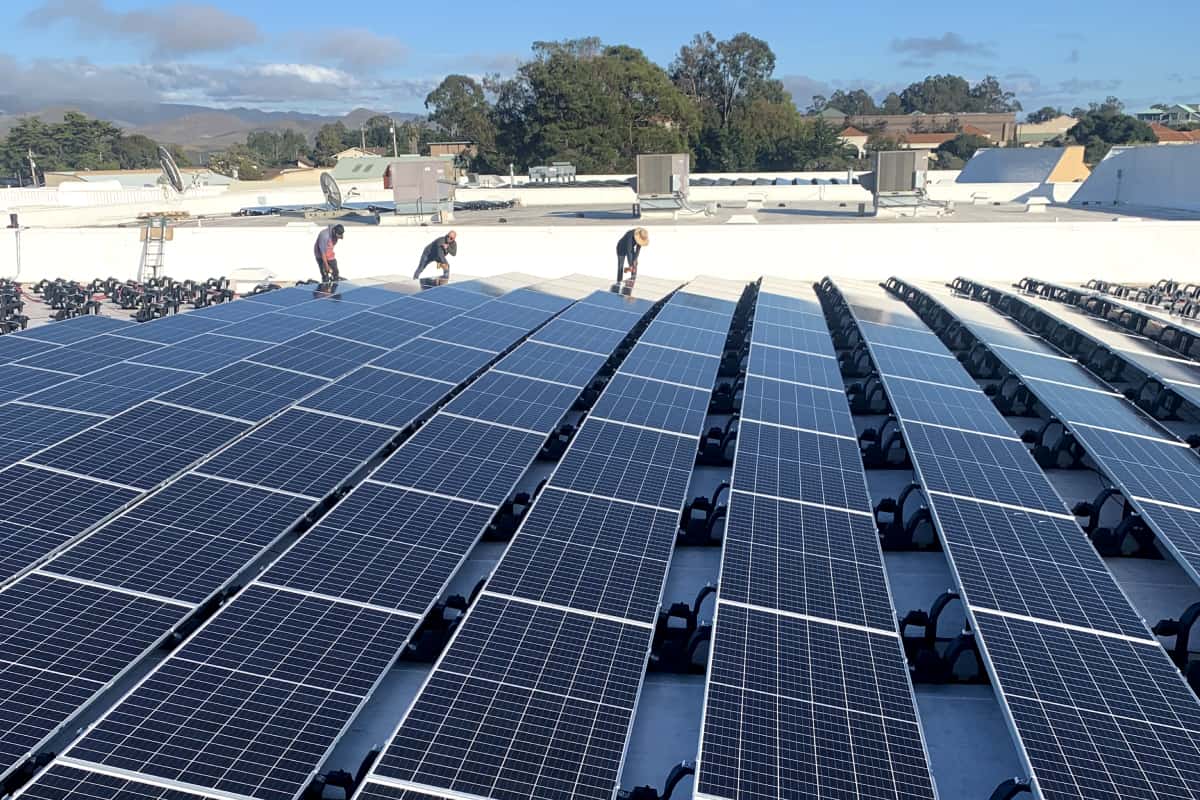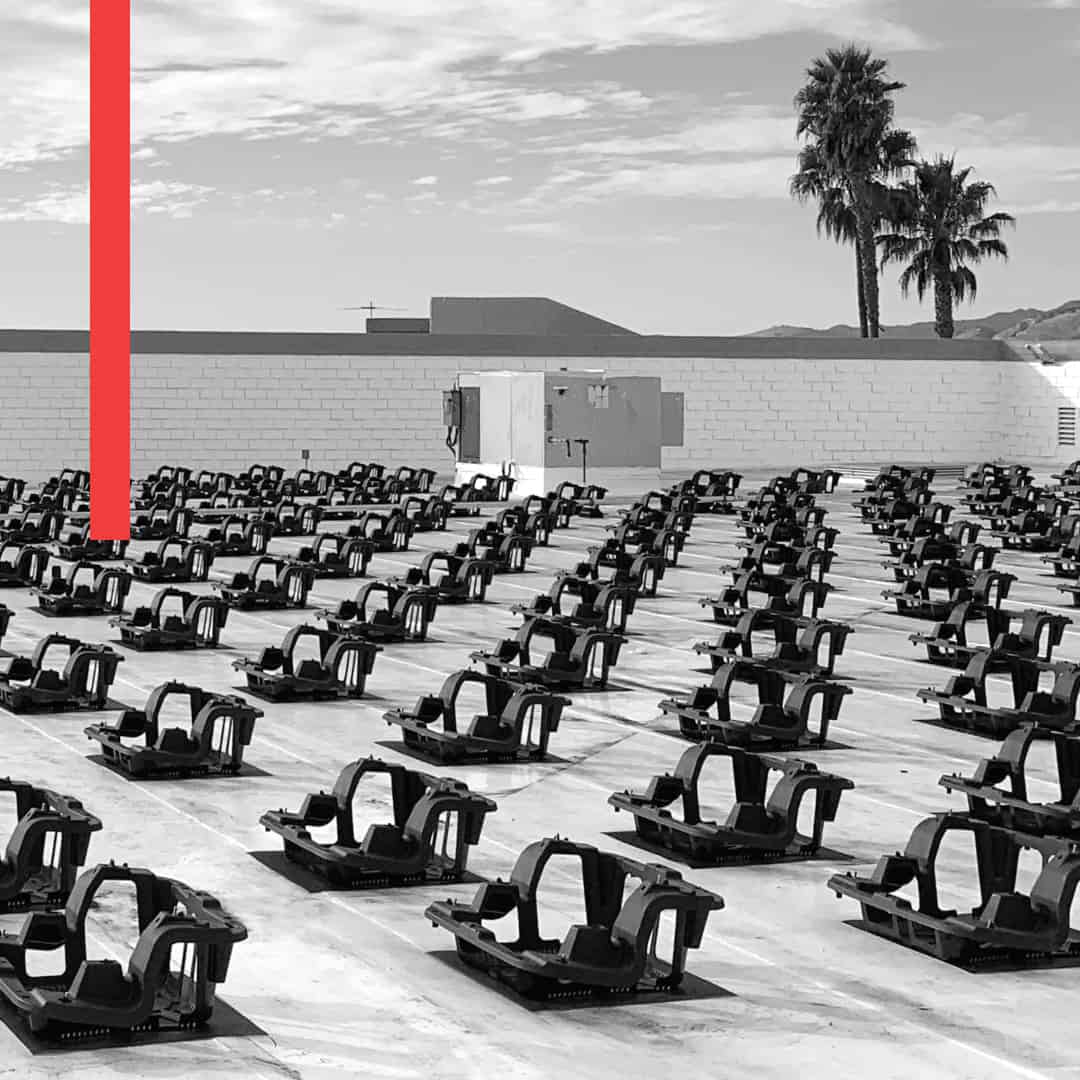If you’re considering solar for your commercial building, it’s safe to assume that you probably have some reservations about your roof. It’s a pretty serious investment that keeps your tenants safe and dry and protects your structure from the elements. The last thing you want is a bunch of contractors roaming around up above, tampering with the building, and voiding warranties.
It’s a reasonable concern, and one that comes up all the time. Commercial property owners worry that adding solar mounting can create leaks and damage infrastructure, especially on flat roofs where water is less likely to run off. Just the mention of solar racks probably conjures up images of contractors strapped to slanting building tops, drilling hundreds of tiny holes into precious and expensive roofs.
Fortunately, those types of mounts are mostly used on residential buildings. There’s a better way to do flat commercial roofs, and it’s a technique called ballasting.
Ballasted solar racking is generally the best choice for commercial buildings, offering minimal risk and maximum performance for the life of a solar system.
What is a ballasted system?
Ballasted solar racking is a mounting system for solar panels created for flat roofs with slopes of around one to seven degrees. They are generally circular or square frames made from industrial-grade plastic or aluminum, featuring top clamps for solar panels and a bottom “pan” that holds a counterbalancing weight.
Instead of relying on penetrations, sealant, and flashing like traditional methods, ballasted solar racking uses the power of gravity to physically weigh down panels to the structure. To keep panels in one place, solar installers set concrete blocks or landscaping pavers in the pan, although water jugs or sand are also sometimes used. The pan section is designed to reduce pressure points and prevent water pooling to protect the surrounding area.
Ballasted solar racking also has a pre-specified tilt to maximize productivity and reduce shading from surrounding panels, traditionally 10 degrees or below. This also ensures safety against wind lift by reducing the amount of drag that panels will encounter. Once installed, a ballasted solar system generally adds a distributed two to six pounds of extra weight per square foot, an amount that an up-to-date roof should easily handle.
How to install ballasted mounts
Installing ballasted solar racking is a fairly straightforward process for an experienced solar contractor. After an engineer designs a system and completes a structural analysis, the mounts are ready for placement. Contractors unload the racks and set them on the roof, where they mark the required ballast locations, paying close attention to spacing. They then arrange the racks on their marks, and weights are added to each of the pans.
After the mounts are positioned, contractors set solar panels onto the weighted ballast racks and secure them with clamps. The modules are connected together with a wiring harness that is then routed beneath the ballasted system. Finally, they ground the solar system with bonding jumpers to ensure safety.

Occasionally, a ballasted rack system will require a hybrid of weight and anchors for correct installation, usually if the roof is subject to high winds, geological concerns, or weight restrictions. This anchor is secured using a few attachment points, heat welded and sealed, and then the ballasted mounts are linked to the system using strut.
Advantages of ballasted solar racking
There are a number of benefits to using a ballasted solar system instead of traditional roof racking. A ballasted system on your commercial roof offers:
Limited to no penetrations
Because a minimal number of holes are needed to install a ballasted system, there’s a reduced risk of leaks that could arise from the installation of the solar system. It also mitigates issues that can complicate roof warranties.
For property owners, it’s a simple tradeoff. A traditional racking system can create 100’s of penetrations that would need sealant, while a ballasted system generally only requires some added weight to the top of your structure. But, every project is different, and even ballasted solar racking could require a few anchors depending on location.
Flexible positioning
The unfixed nature of ballasted systems also make them easily moveable if a need arises. Suppose a new tenant moves into the building and needs to add a new AC unit, or if a particular section of the roof needs a patch. It’s simple to remove panels from their clamps, take weights out of their ballasts, and shift racking mounts without too much hassle. This creates easy access and allows for on-the-fly adjustments by maintenance teams.
Smoother installation
It’s also usually faster and cheaper for solar contractors to ballast solar panels instead of setting them on traditional residential racking. Because of their uniform size and shape, the mounts are easily stackable, reducing freight costs and transportation time to get them on site. Once there, most ballasted systems are also ready to go without pre-installation setup once unloaded from the pallets. This all creates a simpler experience for solar contractors and can lead to a faster time to operation.
Considerations for ballasting
When considering ballasted mounts for your building, it’s important to:
Work with a professional engineer
While it may sound easy to build a ballasted system on your own, it’s extremely important to let a professional engineer handle the details. They’ll run all the necessary calculations in advance, taking into account safety factors like roof load, climate, wind physics, and equipment strength before your panels arrive on site.
They’ll also ensure that the system is set up for maximum solar production by positioning panels at the correct tilt angle and noting exclusion areas for obstacles and shadows. A quality solar engineer will set your solar system up for success, keeping your building safe and power generating for the life of the project.
Use the right ballasting material
It’s also incredibly important to use the right kind of weights in a ballasted system, as they keep panels from moving or shifting during operation. Although it often takes a long time, environmental factors can degrade or damage improper concrete-based weights, especially if they’re exposed to UV rays or freezing and thawing. Ballasting material comes in a variety of ratings and quality levels, so using a solar contractor that checks if the ballasting material is right for the local environment can contribute to the system’s longevity. In addition, routinely checking the condition of the material can prevent any potential issues before they arise.
Getting ballasted solar racking for your building
There are a lot of details associated with solar installations, so getting in contact with the right parties for your project can make all the difference. Working in tandem with your solar engineer, contractor, roofer, and utility is an important part of making sure that any system, ballasted or not, is set up correctly. To do so, you’ll likely need an experienced project manager to handle the specifics.
King Energy makes it easy to bring solar to your commercial building, managing the project from end to end. Our project management team and partners have created solar systems using ballasted solar racking in shopping centers, malls, office parks, and multi-tenant buildings all over California. We’ll manage the details for you, creating an productive solar system using the most up-to-date techniques and materials.
Plus, instead of requiring investments or fees from property owners, King Energy actually rents their roof space, paying for the installation and maintenance of the solar system. Our team scopes the project, manages the details, coordinates install, handles billing, and cleans and repairs the panels for the life of the project. Landlords benefit from an increased rent roll and tenants get access to sustainable energy at 10% off the utility rate.
Contact us for a free proposal and rent estimate today.
